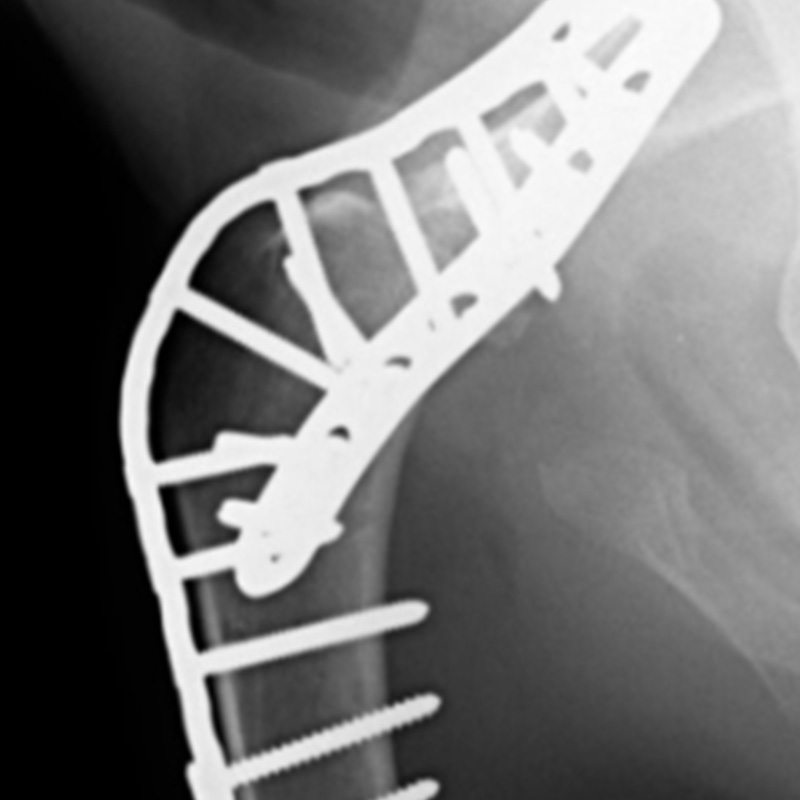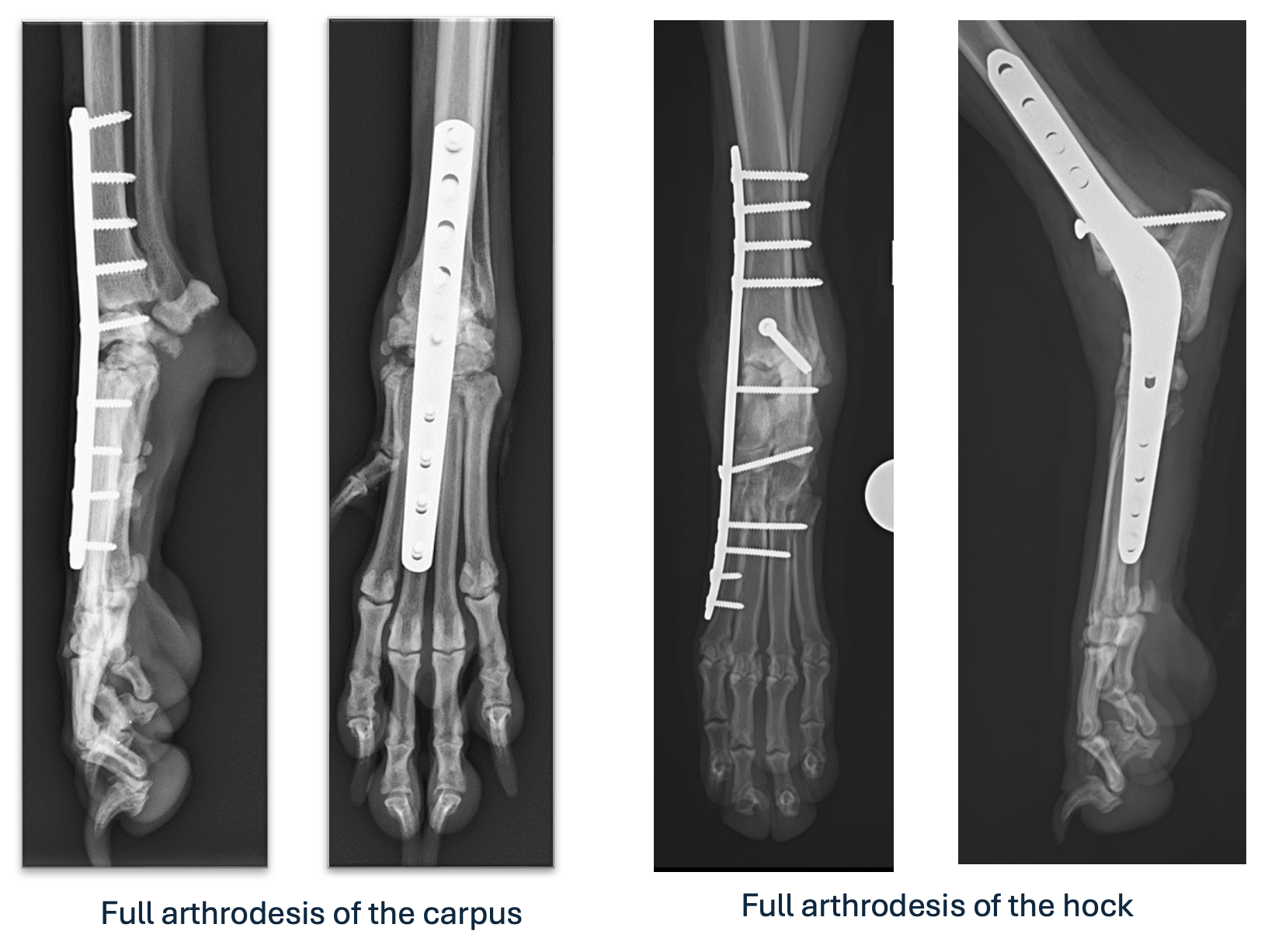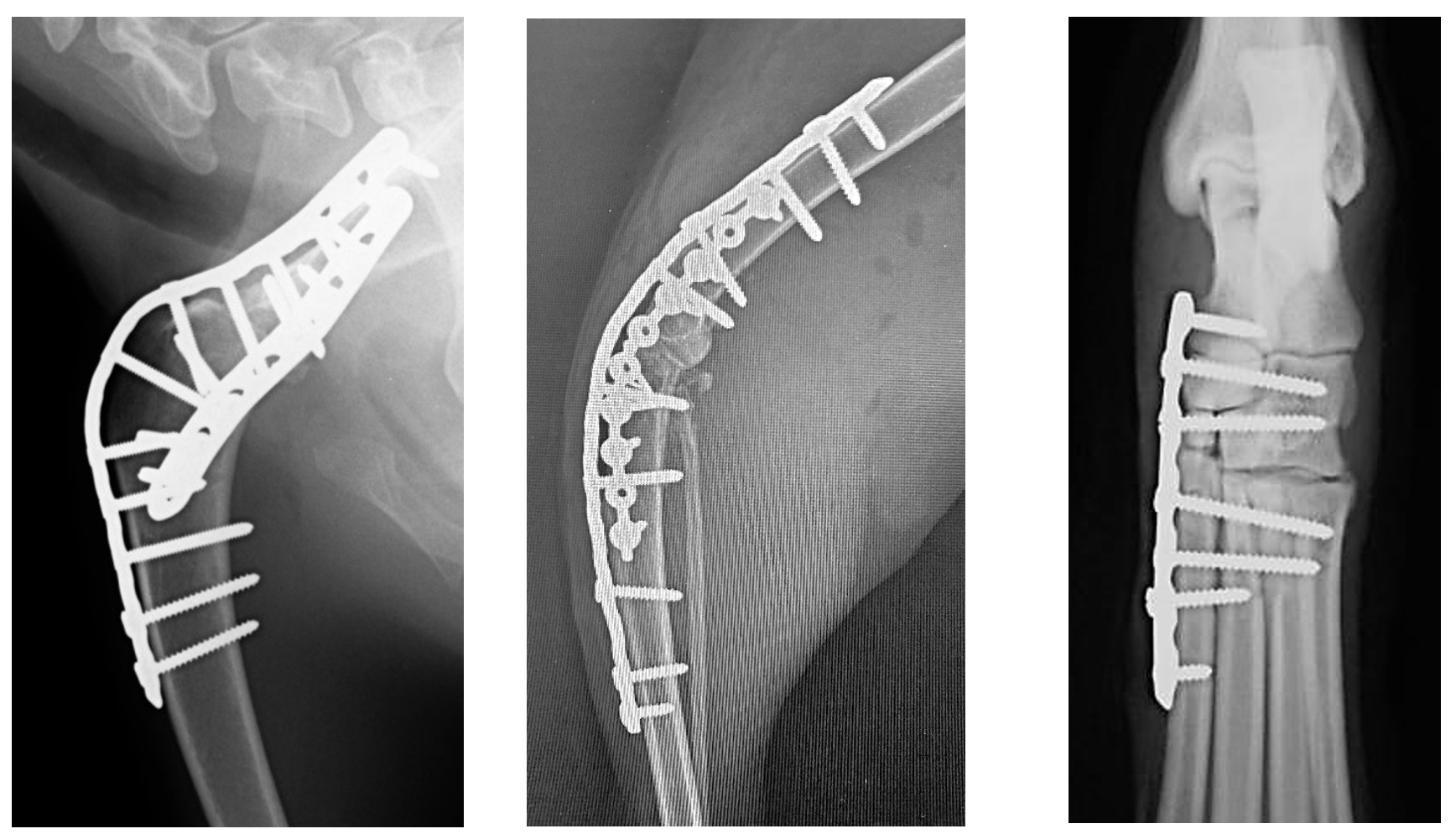Arthrodesis

Arthrodesis – what does this mean for my pet?
Arthrodesis is the surgical fusion of a joint so that it no longer moves. Arthrodesis is a salvage procedure which means we only reach for it when there is no other effective solution. Once fused the joint is no longer painful and continues to function in a load bearing capacity restoring acceptable function of the leg.
Whilst joint pain will be eliminated, the loss of joint movement will result is some change to the way the leg will be used (mechanical lameness) or the way the patient may sit. The amount of mechanical lameness expected varies between joints from none to marked. The joints which are most commonly arthrodesed are the carpus (wrist), hock (ankle) and shoulder; when present mechanical lameness associated with fusion of these joints is often only mild and well tolerated by the patient, allowing them to lead quite normal, active lives. It is less common to fuse joints such as the elbow, knee (stifle) and toes (digits) as mechanical lameness is generally marked resulting in poor mobility despite the absence of pain. Fortunately, total knee replacement and total elbow replacement may be alternative options for some patients where a knee or elbow salvage procedure is required. The hip joint cannot be fused, but thankfully other effective salvage surgeries are available, in particular total hip replacement.
Why might my pet require arthrodesis surgery?
The most common conditions requiring arthrodesis surgery include:
- Intractably painful osteoarthritic joints where joint-preserving surgeries (i.e. replacement) are not available or considered suitable.
- Chronically infected joints.
- Ligament or tendon injury or degeneration which results in joint instability and / or an abnormal leg posture. The carpus and hock joints are most affected by such problems.
- Fracture of or adjacent to a joint, where it is not possible to piece the jigsaw of bone pieces back together, or if done so, where the repaired joint is likely to develop significant osteoarthritis and loss of mobility resulting in chronic pain and poor mobility.
How is arthrodesis achieved?
The joint’s cartilage surface must be meticulously removed, and a substance (bone graft) placed within / around the joint to encourage bone production joint fusion. The joint must then be fixed in a position that allows the patient to use the leg as best possible. The joint is held in this position using implants, most commonly a metal plate(s), screws and sometimes pins. This creates a very strong repair and an environment which provides the best chance for joint fusion to occur over the following months.
How long is the recovery?
The recovery period following surgery will vary depending on which joint is fused, however recovery is usually around 12 weeks. Strict activity restrictions are imposed for the first 6 weeks, after which controlled lead activity and freedom within the house are then progressively restored over the remainder of the recovery period. Full postoperative management and activity instructions will be explained and provided by the team when you collect your pet after their surgery. Initial checks on the wound and removal of any bandage or skin stitches will be undertaken by your own vet, however a follow up appointment will be arranged with your surgeon for approximately 6 weeks after surgery to ensure that your pet is making expected progress. At this follow up x-rays will be obtained under a light sedation to check the implants and to assess for joint fusion. If all is progressing as expected further rehabilitation guidelines will be given, and any further assessments scheduled. Unless indicated implants remain in place for life.

What is the outlook following surgery?
A good to excellent outcome is expected following arthrodesis surgery in most patients. Remember, depending on which joint is arthrodesed there may be an expectation for some change to the way your pet will use their operated leg i.e. their mechanical lameness. The anticipated outcome for your pet will be discussed with you prior to surgery. For most patients on-going painkilling medications will not be required.

What are the potential complications following surgery?
Arthrodesis is a major surgical procedure and would not be offered for your pet if your surgeon did not feel it was necessary. Our surgeons will have a thorough discussion with you ahead of surgery to make sure you are fully informed regarding possible complications. Whilst complications can develop after any arthrodesis procedure the type and frequency of complications differs between joints. If a complication develops your pet is likely to require assessment by your surgeon. Additional investigations such as x-rays are likely to be required.
Complications that can be encountered include:
Infection – will require antibiotic medication ideally based on the results of sample analysis. For some patients infection may necessitate further surgery for it to be resolved.
Implant problems such as loosening or breakage – These may be seen if patients do more activity than is permitted during the recovery period, can be associated with infection or if the joint fails to fuse over time. Most implant problems will necessitate further surgery.
Wound problems – Whilst these can be seen following any surgery, the risk is slightly greater when performing arthrodesis of the wrist and ankle joints due to the limited skin cover in these locations. Wound management within the first few weeks of surgery is of vital importance to minimise this risk. Bandages / dressings are often applied to the lower limb for a short period after surgery to minimise swelling and prevent the patient interfering with the wound. Remember patients always lick worse not better!
Fracture – of bones adjacent to the fused joint may occur due to the abnormal forces that result following arthrodesis surgery. This complication may necessitate further surgery.





